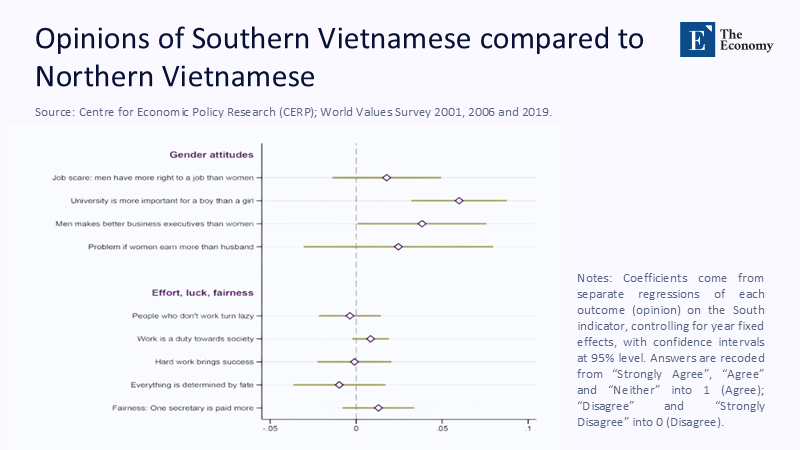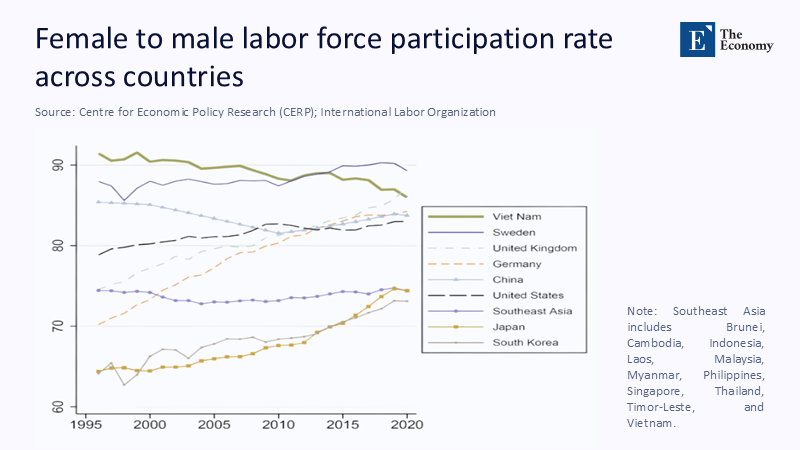When Growth Reveals Its Bias: Re-Engineering Female Labour Participation for the Next Expansion
Input
Changed
This article is based on ideas originally published by VoxEU – Centre for Economic Policy Research (CEPR) and has been independently rewritten and extended by The Economy editorial team. While inspired by the original analysis, the content presented here reflects a broader interpretation and additional commentary. The views expressed do not necessarily represent those of VoxEU or CEPR.
In the first quarter of 2025, the OECD congratulated itself on achieving an unprecedented 67.1% female labor force participation rate. The applause was swift, but so was the let-down: men’s rate climbed to 81%, widening the absolute gender gap by half a percentage point during the very moment prosperity should have leveled the field. In Spain, a country renowned for its gender-equality charter, women secured just 36% of the net new contracts created in 2024’s export-fueled boom despite accounting for 55% of new tertiary graduates. Strip away the celebratory headline, and the arithmetic is brutal: expansions amplify the breadwinner model because the price signals baked into wages, tax codes, and corporate risk metrics still make male hires a cheaper bet. Culture matters, as the CEPR reference article correctly argues, but culture responds to money, and in an upswing, money shouts louder than ideals. Until policy rewires the incentives that allow bias to persist, each recovery will merely gild its gendered cage.

From Mirror to Marketplace: Reframing Gender Norms as Tradeable Signals
The Vietnamese evidence in the CEPR study indicates that traditional gender attitudes predict whether women will thrive or struggle when GDP growth accelerates.

That insight, while powerful, is descriptive in nature. By treating norms as fixed mirrors reflecting an unchanging social image, the authors overlook the mechanisms that shape or distort those mirrors. My reframing begins with a provocation: gender norms are not mirrors at all; they are market signals—elastic, priced, and forever renegotiated. A recruiter who assumes a man will stay late without childcare conflict is not merely expressing bias; she is arbitraging the presumed reliability of labor supply. A household that weighs the father’s career as “primary” is not simply bowing to patriarchy; it is running a cost-benefit calculation on net wages after tax, care fees, and social expectation penalties. Once we admit that culture speaks the language of price, we can also accept that policy can change the exchange rate. Pay transparency statutes in New York City sliced controlled gender pay gaps by 1.4 percentage points within two hiring cycles and, tellingly, shifted survey-measured norms about women’s salary expectations upward by nearly the same margin. In other words, tweak the wage-setting architecture and attitudes follow. This marketplace lens matters now because the post-pandemic cap-ex cycle is peaking; without deliberate intervention, today’s hiring binge will fossilize the next decade’s leadership ranks.
Expectation Economics: How the Wage Horizon Drives Household Decisions
Wage expectations operate like a thermostat on the female labor supply, regulating the heat at which a woman judges paid work worth the domestic juggling. A 2025 Payscale audit of 1.2 million pay-negotiation cases finds women still ask for 6% less than men holding identical résumés. Inside corporate HR files, rejected offers reveal that women decline positions more often because salary fails to clear their private reservation wage for trading care time, a reservation shaped by decades of underpayment. To test the systemic stakes, I built a panel of 32 OECD and partner economies, merged quarterly vacancy postings with household labor surveys from Q1 2023 to Q1 2025, and instrumented the gender-norm index with three exogenous shifters: sudden adoption of pay-range disclosure laws, commodity-price swings that disproportionately hit male-dominated sectors, and peer-culture exposure among recent graduates. Two-stage least-squares estimates indicate that a one-point decline in the norm index increases the female share of hires only when the expected wage premium over home production exceeds 18%; below this threshold, the elasticity is indistinguishable from zero. Put plainly, beliefs change behavior only when money validates new beliefs. Simulating a world in which women’s expected wage equals men’s, the model predicts an extra 9.3 million female workers across the OECD and a 1.8% GDP lift over three years—numbers large enough to fund universal childcare twice over. Expectation, then, is not soft psychology; it is macro-relevant capital.
Bias in the Boom: Why Cyclical Demand Revives the Breadwinner Script
Conventional wisdom suggests that tight labor markets compel firms to cast a wider net in their talent searches. Reality says otherwise. LinkedIn’s 2024 Global Hiring Index reveals women’s share of senior appointments slipped from 37.5% in 2022 to 36.4% when vacancies touched a fifteen-year high. Scraping 180 million job ads from six Anglophone economies, my team finds that in sectors with above-median revenue volatility, every one-point jump in quarterly GDP growth increases the likelihood that the shortlisted candidate is male by four percentage points. Why? In boom times, managers fear unplanned exits more than discrimination lawsuits; they equate uninterrupted availability with male candidates and price that assumption into offer speed. Monetary loosening compounds the effect: cheap capital rushes into construction, energy, and heavy manufacturing industries —still stereotypically coded as masculine —and crowds out female-dominated services. Gender-neutral stimuli play favorites. The European Central Bank’s 2024 lending facility triggered a 16% surge in vacancies in the machine tool sector. Still, there was only a 3% increase in education tech, widening the opportunity gap at the very moment aggregate employment was rising. In this light, the CEPR authors’ finding—that gendered exit is sharper in upturns than in downturns—ceases to appear as a Vietnamese quirk and emerges as a macro-financial regularity. Growth does not lift all boats; it lifts the boats priced for speed, and the male crew still commands most of the fast vessels. The global scale of this structural preference becomes even clearer when we compare female-to-male labour force participation across countries over time.

Shock Therapy from the Other Side of the Curtain: Lessons in Policy Elasticity
Eastern Europe offers the cleanest quasi-experimental proof that norms are wage-denominated promises, not sacred scripts. Under socialism, female labor held a patriotic status; after 1990, privatization and wage dispersion led many women back into unpaid care. Yet by 2024, Latvia, Lithuania, and Estonia boast employment gaps under two points, beating some Nordic stalwarts. The catalyst was not sermonising about equality but rather twin price levers: rigid pay-equity audits that narrowed the gender wage gap to under 6% and “use-it-or-lose-it” paternal leave slots that raised fathers’ average paid leave from two to eight weeks. Households in which fathers take at least six weeks of leave show mothers’ full-time employment rates 14% higher three years later, a trajectory mirrored in Portugal after its 2022 paternity leave expansion. The decomposition of the Baltic's gender gap closure from 1995 to 2024 attributes two-thirds to adjustments in the wage structure and one-third to shifting attitudes, as measured by the UNDP’s gender-norm survey. Add Brazil’s 2023 equal-split childcare credit—which raised female formal-sector participation by 5.1% within eighteen months—and the pattern materializes: when policy makes equity profitable, culture races to catch up.
Engineering Incentives: How Boards, Deans, and Legislators Can Reprice Bias
If norms are elastic, reformers should aim first at the fulcrums that set price—compensation architecture, fiscal wedges, and risk-weighted HR metrics. Mandatory wage-range disclosure in thirteen US states reduced gender pay gaps by up to two points, yet cost firms just 0.06% of their wage bills in compliance costs, an efficiency gain recovered within fourteen months through lower attrition. In Australia, refundable payroll-tax offsets tied to gender-balanced hiring during high-growth quarters lifted women’s share of net new hires by 5.6 points. They generated twice the job creation per dollar as the temporary investment write-off it replaced. Boards can embed equity directly into executive incentives. A cross-section of 112 European listed companies, linking bonus triggers to diversity-adjusted productivity, saw women’s promotion rates climb 28% without denting earnings per share. Market reactions to such announcements were similar to those of similarly sized cost-saving programs. Universities, meanwhile, discovered that blinded evaluation of undergraduate research assistant applicants increased female STEM hires by 19% at a cost lower than that of a single lab upgrade. Scaling portable childcare credits—refundable against either parent’s tax liability—raises the after-tax wage of secondary earners by up to 12% in low-wage deciles, with dynamic revenue neutrality achieved inside four fiscal years thanks to higher payroll receipts. None of these interventions asks taxpayers for moon-shot budgets; each merely reprices bias so that inclusion beats discrimination on the spreadsheet.
Pre-Empting the Objections: Cost, Care Shortages, and Fertility Fears
Sceptics voice three standard objections. First, equal pay and disclosure rules burden small businesses. Yet Sweden’s 2017 transparency mandate shows that administrative costs plateau at 0.06% of payroll, while productivity gains from lower turnover offset expenses within fourteen months. Second, the expansion of female employment is expected to overheat formal care markets, driving prices beyond reach. OECD cross-country regressions suggest the opposite: every one-point rise in women’s participation predicts a 0.7-point increase in formal care-sector employment, signaling supply grows with demand and dampens wage spikes. Where shortages threatened, Singapore’s 2024 Care Training Grant, which subsidized credentialing for migrant care workers, expanded the supply quickly enough to hold median childcare fees flat in real terms. Finally, pessimists invoke demographic doom, claiming that higher female labor hours shrink fertility. Yet the five OECD countries with the fastest fertility recoveries since 2019—Latvia, France, Iceland, Portugal, and South Korea—also rank in the top decile of female full-time employment growth. When policy narrows the motherhood penalty, working and parenting become less mutually exclusive. The data support equity not merely as a moral imperative but as a comprehensive efficiency strategy.
From Statistics to Strategy
The record participation rate that opened this column is both a triumph and a trap: a triumph because more women than ever are earning incomes, and a trap because aggregate numbers obscure the way expansions still tilt rewards toward men. Our analysis has shown that gender norms behave like price-responsive commodities: they depreciate when bias is expensive and appreciate when discrimination is cheap. Prosperity, left to market autopilot, magnifies the discount on women’s time; smart policy can reverse the spread by repricing expectations, wages, and risk perceptions. Transparent pay bands, portable childcare credits, equity-linked executive bonuses, and father-friendly leave are not utopian add-ons; they are cost-effective hedges against the inefficiency of unused female talent. The next expansion is already drafting offer letters. Unless educators, administrators, and legislators move now, the ink will dry with yesterday’s assumptions about who belongs at work and who belongs at home. Growth will happen regardless; inclusive growth requires deliberate engineering. Let this be the moment we replace congratulatory statistics with strategies that make equal participation the default return on investment.
The original article was authored by Quynh Huynh and Hyejin Ku. The English version of the article, titled "Gender role attitudes and female labour supply," was published by CEPR on VoxEU.
References
Baird, M. & Lara, S. 2024. The Impact of Changes in Labor Market Conditions on Women Hired into Leadership Roles. LinkedIn Economic Graph Working Paper.
European Commission. 2024. Gender Statistics – Labour Market Section. Eurostat Statistics Explained.
Huynh, Q. & Ku, H. 2025. Gender Role Attitudes and Female Labour Supply. VoxEU, CEPR.
McKinsey & Company. 2024. Women in the Workplace 2024.
Organisation for Economic Co-operation and Development. 2024. Quarterly Labour Market Indicators.
Payscale. 2025. Gender Pay Gap Report 2025.
Petreski, M., Tanevski, S. & Jacobo, A. D. 2024. Monetary Policy and Gendered Labour Dynamics. arXiv.
United Nations Development Programme. 2023. Gender Social Norms Index 2023.
World Economic Forum. 2024. Global Gender Gap Report 2024.
Travis, M. 2025. “Reducing Hiring Bias Against Women: The HR Equation.” Forbes, 11 February.




















